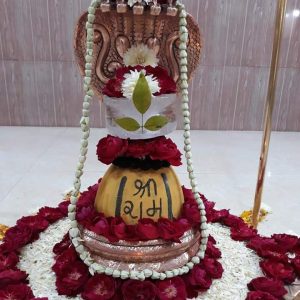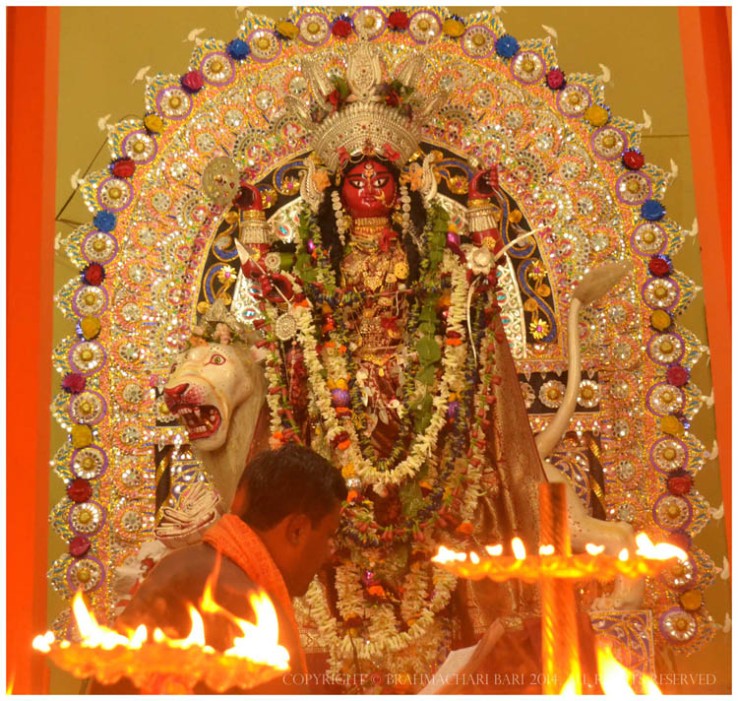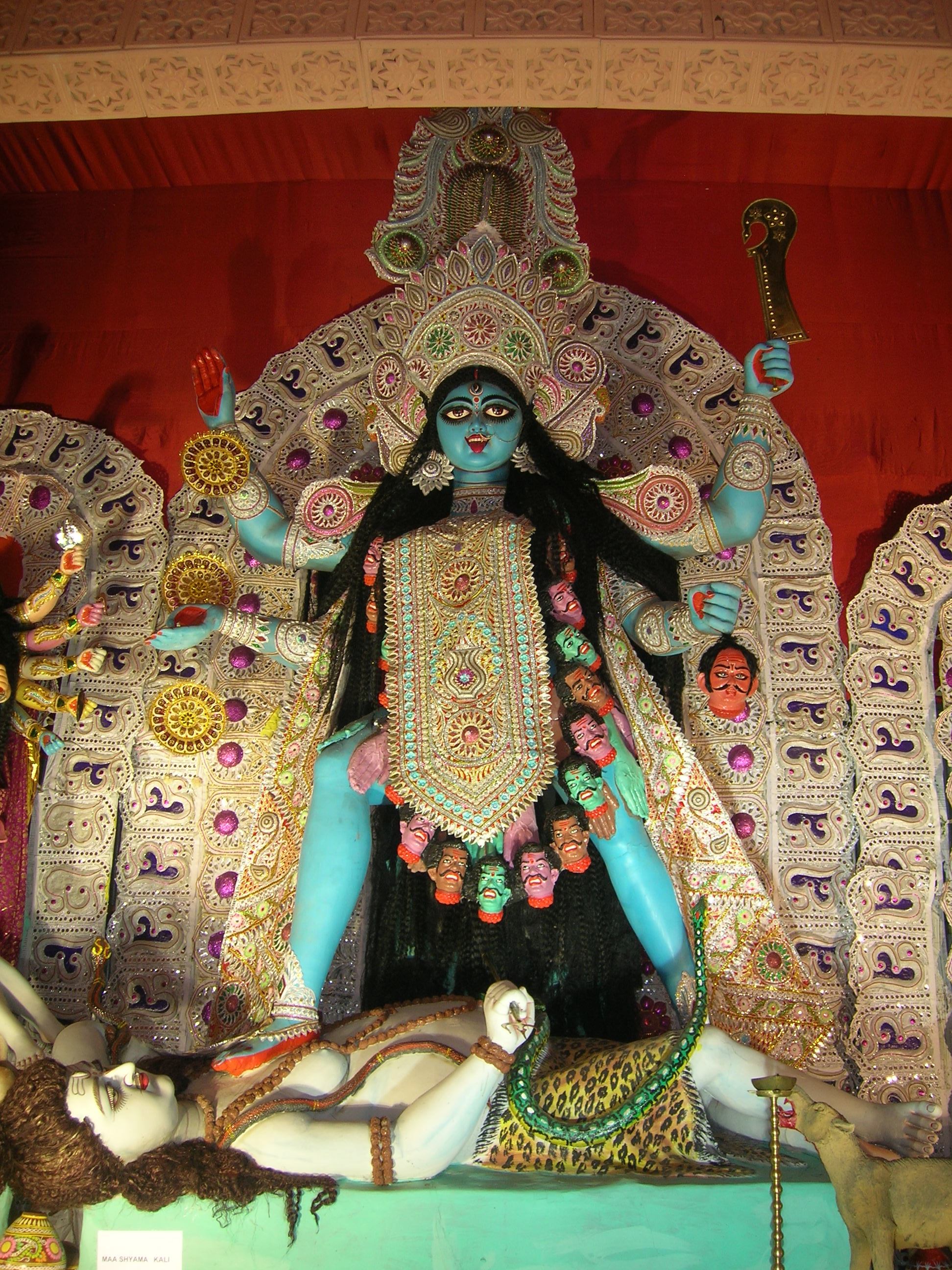nārada uvāca
sarvākhyānaṃ ṣrutaṃ brahmaktratīva paramādbhūtam|
adhūnā śrotumicchāmi durgopākhyānamuttamam||
dūrgā nārāyañīśānā viṣṇumāyā śivā satī|
nityā satyā bhagavatī śarvāṇī sarvamaṇgalā||
ambikā vaiṣṇavī gaurī pārvatī ca sanātanī|
nāmāni kauthumoktāni sarveṣaṃ śubhadāni ca||
Nārada said:Oh Brāhmaṇa,I have listened to this astonishing story. Kindly tell me the story of Durgā that I want to listen from you. Her names as described in the Kauthuma śākhā(of the Sāmaveda) are Durgā,Nārāyaṇī,Īśānī,Viṣṇumāyā,Śivā,Satī,Nityā,Satyā,Bhagavatī,Śarvāṇī,Sarvamaṇgalā,Ambikā,Vaiṣṇavī,Gaurī,Pārvatī,Sanātanī and they bestow auspiciousness.
atha śoḍaśanāmnāṃ ca sarveṣāmīpsitaṃ varaṃ।
brūhi vedavidāṃ śreṣṭhaṃ vedoktaṃ sarvasampatam॥
O best of the ones learned in the vedas, please kindly state the meanings of the sixteen names which bestow welfare upon all and are mentioned in the veda.
kena vā pūjitā sadak dvitīye kena vā pūrā।
tṛtīye vā catūrthe vā kena sarvatra pūjitā॥
Who was the first to worship Her?After that, who was the second, third and fourth to worship Her?
nārāyaṇa uvāca
atha ṣoḍaśanāmnāṃ sa viṣṇuvedi cakāra saḥ।
jñātvā punaḥ pṛccasi tvaṃ kathayāmi yathāgamam॥
Nārāyaṇa said:Viṣṇu has already given the sixteen names in the vedas and you are well aware of them. In spite of that you are asking me the question again and I am now speaking what has been said in the śāstra.
durgo daitye mahāvighne bhavabandhe ca karmaṇi।
śoke duḥkhe ca narake yamadaṇḍe ca janmani॥
mahābhaye’tiroge cāpyāśabdo hantṛvācakaḥ।
etānhantyeva yā devī sā ḍurga parikīrtitā॥
The word ‘Durga’ stands for a daitya who was a great obstruction representing worldly bondage,karmas,sorrows,hells,yama’s rod, births,great dangers, disease and ‘a’ represents the killer of the same. Therefore the one who destroys them all is famed as ‘Durgā’.
yaśasā tejasā rūpairnārāyaṇasamā guṇaiḥ।
śaktirnārāyaṇasyeyaṃ ṭena nārāyaṇī smṛtā॥
In glory,lusture,beauty and qualities She is like Nārāyaṇa and She is His śakti. Hence She is called Nārāyaṇī.
īśānaḥ sarvasiddharthe cāśabdo dātṛvācakaḥ।
sarvasiddhipradātrī yā sā’pīśānā prakīrtitā॥
Īśāna is a word used for sarvasiddhi(all-accomplishment) and ‘ā’ stands for its giver. Therefore the one who bestows sarvasiddhi is called Īśānā.
sṛṣṭā māyā purā sṛṣṭau viṣṇunā paramātmanā।
mohitaṃ māyayā viśvaṃ viṣṇumāyā prakīrtitā॥
In times of yore,Viṣnu created māyā,by means of which the whole universe was deluded by Her. She is thus called Viṣnumāyā.
śive kalyāṇarūpā ca śivadā ca śivapriyā।
priye dātari cāśabdo śivā tena prakīrtitā॥
She’s beloved of Śiva and is the form of Śiva’s auspiciousness and giver of Śiva,hence She is called Śivā.
sadbuddhyadhiṣātṛdevī vidyamānā yuge yuge।
pativratā suśīlā ca sā satī parikīrtitā॥
Every Yuga after Yuga,She’s the presiding deity of sad-buddhi(right intelligence),She is a chaste lady and well-disposed,hence She is called Satī.
yathā nityo hi bhagavān nityā bhagavatī tathā।
svamāyayā tirobhūtā tatreśe prākṛte laye॥
ābrahmastambaparyantaṃ sarvaṃ mithyaiva kṛtrimam।
dūrgā satyasvarūpā sā prakṛtirbhagavānyathā॥
siddhaiśvaryādikaṃ sarvaṃ yasyāmasti yuge yuge।
saiddhādike bhago jñeyastena sā bhagavatī smṛtā॥
She is eternal like Viṣṇu,and merges into Him at the time of the dissolution of the universe. Everything from a straw to Brahmā is transient and artificial(in contrast). She is also of the nature of Satya(truth) like Viṣṇu. ‘Bhaga’ denotes all siddhi and aiśvarya(lordliness/wealth),and since She is of that nature,She is called ‘Bhagavatī’.
sarvānmokṣaṃ prāpayati janmamṛtyujarādikaṃ।
carācarāśca viśvasthāñcharvāṇī tena kīrtitā॥
She gives mokṣa to all and is the cause of birth, death and old age of all, hence She is called Śarvāṇī.
maṅgalaṃ mokṣavacanaṃ cāśabdo dātṛvācakaḥ।
sarvānmokṣānyā dadādi saivasyātsarvamaṅgalā॥
The word ‘Maṇgala’ means auspiciousness and ‘ā’ stands for its giver. Since she gives auspiciousness to all,She is called sarvamaṇgalā.
harṣe saṃpādi kalyāṇe maṅgalaṃ parikīrtitaṃ।
tāndadāti ca sarvebhyastena sā sarvamaṅgalā॥
The word ‘Maṇgala’ means pleasures and auspiciousness which She bestows upon all. Hence She is called Sarvamaṇgalā.
ambeti mātṛvacano vandane pūjate sadā।
pūjitā vanditā yātā jagatāṃ tena sā’mbikā॥
The word Ambā means mother and is used for worship and adoration. Hence,the Mother who is worshipped by all is called Ambikā.
viṣṇubhaktā viṣṇurūpā viṣṇoḥ śaktisvarūpiṇī।
sṛṣṭau ca viṣṇunā sraṣṭā vaiṣṇavī tena kīrtitā॥
The devotees of Viṣṇu call Her Vaiṣṇavī because She is the form and energy of Viṣṇu,and by Her is the whole universe is created.
gauraḥ pīte ca nirlipte pare brahmāṇi nirmale।
tasyātmanaḥ śaktiriyaṃ gaurī ṭena prakīrtitā॥
guruḥ śambhuśca sareveṣāṃ tasya śaktiḥ priyā sati।
guruḥ kṛṣṇaśca tanmāyā gaurī tena prakīrtitā॥
tithibhede parvabhede kalpabhede’nyabhedake।
khyātau teṣu ca vikhyātā pārvatī tena kīrtitā॥
mahotsavaviśeṣe ca parvatriti sukīrtitā।
tasyādhidevī yā sā ca pārvatī parikīrtitā॥
parvatasya sutā devī sāvirbhūtā ca parvate।
parvatādhiṣṭhātṛdevī pārvatī tena kīrtitā॥
She is golden complexioned, clad in yellow garments, unattached and spotless. Because She is the śakti of the Ātman She is called Gaurī. She’s is tithibheda,kalpabheda,and one who causes the bhedas between these tithes,kalpas and other bhedas. She is thus called Pārvatī. During special celebrations, the word pavan is used, and since She is the Goddess of all parvenus,She is called Pārvatī. She is also called Pārvatī because She is the daughter of the mountain, appeared over the (Himalaya) mountain, and is the Goddess of mountains.
sarvakAle sanA prokto vistR^ite cha tanIti cha|
sarvatra sarvakAle cha vidyamAnA sanAtanI||
arthaH ShoDashanAmnAM cha kIrtitashcha mahAmune|
yathAgamaM taM vedoktopAkhyAnaM cha nishAmaya||
The word ‘sanā’ is used for all times, and in expanded form,’tanī’ is added to it. Since She is present in all times and all places,She is called Sanātanī. O sage,I have explained the meanings of Her sixteen names. I am now narrating the stories of Her as told in the vedas. Listen to me!
prathame pūjitā sā ca kṛṣṇena paramātmanā।
vṛndāvane ca sṛṣṭyādau goloke rāsamaṇḍale॥
madhukaiṭabhabhītena brahmaṇā sā dvitīyate।
tripurapraritenaiva tṛtiye ca tripurāriṇā॥
bhraṣṭaśriyā mahendreṇa śāpāhurvāsasaḥ purā।
caturthe pūjitā devī bhaktyā bhagavatī satī॥
tadā munīndraiḥ siddhendrairdevaiśca munipuṅgavaiḥ।
pūjitā sarvaviśveṣu samabhūtsarvataḥ sadā॥
In times of yore, at the beginning of creation and in the Rāsamaṇdala of Goloka in Vṛndāvana,Kṛṣṇa adored Her. Secondly,Brahmā adored Her to get relief from Madhu and Kaiṭabha. Thirdly,Śiva adored Her when He went to war with Tripura. Fourthly,Indra adored Her after He was cursed by Durvāsā,as a result of which He lost all riches and glory. Since then,She has been popularly adored by all the sages,siddhas,Gods and Ṛṣis everywhere.
The text after this then alludes to Suratha and Samādhi who adored the Goddess,and one attained the position of Sāvarṇi manu while Samādhi attained Goloka by Her grace.





 )
)